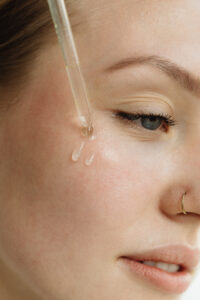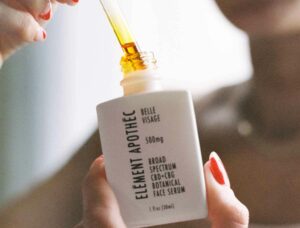Disclosure: I receive a small commission for purchases made via affiliate links.
Acids in skincare are super popular because they can do amazing things for your skin. But I get it, sometimes it can get super confusing, especially when skincare brands throw around all these scientific-sounding names. It’s like, “Wait, is this acid going to melt my face off or make me glow like a goddess?”
So, if you ended up here on this article in search of what lactic acid is, look no further. I’ve got you covered with insights on how to use lactic acid, how to get the most out of it, and—more importantly, whether you even need it in your skincare routine.
What is lactic acid?
Lactic acid is an AHA (alpha hydroxy acid), but it’s one of the milder ones. It helps exfoliate dead skin cells, revealing a smooth and refined texture underneath. Other forms of AHAs include glycolic acid, mandelic acid, citric acid, and malic acid. Lactic acid is the gentler exfoliant among all of them, second only to mandelic acid.
Benefits of using lactic acid
- Gentle Exfoliation: As already mentioned, it gently exfoliates dead skin cells. Unlike glycolic acid, which can be a bit intense for some people, lactic acid is less likely to cause irritation, making it perfect for sensitive skin types.
- Hydration: Lactic acid is also a humectant, which helps your skin retain moisture. This is something I found very interesting, it’s a rare combo to find in an acid. Hydration and exfoliation done by one ingredient. If your skin is dry and dehydrated, lactic acid is your best exfoliating choice.
- Anti-aging benefits: Yes, you heard that right. It increases cell turnover, leading to increased collagen production over time, though not as aggressively as some other ingredients like retinoids or vitamin C. But if anything, it complements your anti-aging skincare routine.
- Brighter complexion: Lactic acid helps fade dark spots, uneven tone, and dullness over time. It’s a great option for anyone looking to achieve a more radiant complexion.
Who should avoid lactic acid?
Ok, now let’s drop some truth bombs. While everything about lactic acid feels good, lactic acid isn’t for everyone. If you’re dealing with super angry, inflamed acne or super reactive skin, you might want to skip it for now and focus on calming your skin first. And if you’re already using strong exfoliants like glycolic acid or retinol, adding lactic acid might be overkill.
Who should use lactic acid?
Honestly, lactic acid is like that friend who gets along with almost everyone. But let’s break it down.
- Beginner skin: If you’re just dipping your toes into the world of chemical exfoliants, lactic acid is a great place to start. It’s not as intimidating as glycolic acid, and it won’t make you regret your life choices the next morning.
- Dull looking skin: If your skin’s looking a little meh, like it partied too hard and forgot to glow somehow, lactic acid can help slough off dead skin cells and bring back that radiance, more like a reset button.
- Dry skin: If your skin feels like a desert, especially if you have dry skin, lactic acid is here to save the day. Not only does it exfoliate, but it also pulls moisture into your skin, keeping it soft and hydrated.
- Sensitive skin: If your skin throws a tantrum every time you try something new, lactic acid is your safe bet. It’s gentle enough to exfoliate without making your skin freak out. Think of it as the “chill” AHA.
- Oily skin: Oily skin often comes with clogged pores and oil overload. Lactic acid helps exfoliate without stripping your skin (unlike stronger acids).

Using Lactic acid and retinol together
While there are three methods that I consider the safest, the alternate night method is the safest of all, and I personally follow this method mostly if I’m not using salicylic acid. When I do, I use salicylic acid and retinol, I stick to using salicylic acid once or twice a week, only on nights when I’m not using retinol.
- Alternate Night method: This method gives your skin a break between actives and reduces the risk of irritation. This is the safest way to use both. For example:
Monday Night: Lactic acid
Tuesday Night: Retinol
Wednesday Night: Lactic acid
And so on. - AM/PM Split Method: You can use lactic acid in the morning and retinol at night, but here’s the catch. In the morning: Lactic acid (followed by sunscreen because AHAs make your skin more sun-sensitive). At night, use retinol. This works because lactic acid is water-based and retinol is oil-based, so they’re not directly competing. Just make sure your skin can handle it.
- The Sandwich Method: If you want to use them on the same day (but not at the same time), you can “sandwich” them with a moisturizer. This buffers the actives and reduces the chance of irritation. Apply lactic acid, wait 20-30 minutes, then apply moisturizer. Later in the evening, apply moisturizer, wait 10-15 minutes, then apply retinol.
Best lactic acid product recommendations
Different products have different concentrations, which begs the question: what concentration of lactic acid should you use? Lactic acid is pretty forgiving, but the percentage still matters depending on your skin type and experience with acids.
Dermatologists usually recommend sticking to 5-10% if you have sensitive skin and expect mild exfoliation. If you want to target hyperpigmentation, you can use more than 10%, but for hyperpigmentation, I personally stick to retinol and vitamin C. (20% is usually found in professional treatments rather than daily skincare products.) I have found 5-10% to be effective and have never felt the need to go beyond that.
- The Ordinary Lactic Acid 5% + HA is the best and safest option for sensitive and beginner skin. It’s affordable and gentle on the skin. It is actually considered to be the closest dupe to the Sunday Riley Good Genes All-in-One Treatment.
- The Ordinary Lactic Acid 10% + HA is perfect for anyone who wants a step up from 5% and is used to using lactic acid. It will give you more noticeable results without breaking the bank. It’s perfect for normal to dry skin and for those who want a little oomph.
- Sunday Riley Good Genes All-In-One Lactic Acid treatment is my most favorite. It’s effective and makes your skin look like it’s been filtered IRL. The key ingredients are lactic acid, licorice root for brightening, and lemongrass for astringent benefits. This one is best for any skin type and for those who wants to splurge for a glowing skin.
- Drunk Elephant T.L.C. Framboos Glycolic Night Serum is not just lactic acid (it’s a blend of AHAs and BHA) and is a cult favorite. They key ingredients are glycolic acid, lactic acid, citric acid and salicylic acid. Best for for oily acne-prone skin and textured skin.
Myth buster: Higher percentages are always better
Not necessarily. Higher percentages can be more effective, but they also come with a higher risk of irritation. Sometimes, less is more, especially if you’re new to acids or have sensitive skin.
Final verdict
Lactic acid is absolutely important in the world of skincare, and it’s kind of an unsung hero compared to some of the more “trendy” acids like glycolic or hyaluronic. It’s like the “Goldilocks” of acids, it’s not too strong, not too weak, but just right for a lot of people. It’s effective, and works for a wide range of skin types and concerns. Plus, it’s been used in skincare for centuries (fun fact: Cleopatra supposedly bathed in sour milk, which contains lactic acid, to keep her skin soft and glowing!).
This post contains affiliate links. If you click through and support Modysch financially (at no extra cost to you), thank you so much! For more details, see the full Disclosure.
Maleeka is an orthodontic resident with a passion for skincare and beauty. She decodes beauty products, breaks down ingredients, and spills the tea on marketing hypes. When she’s not perfecting smiles or geeking out over the latest formulations and trends, you’ll find her binge-watching Netflix.





Pingback: This Affordable Sunday Riley Good Genes Dupe Works Like A Charm